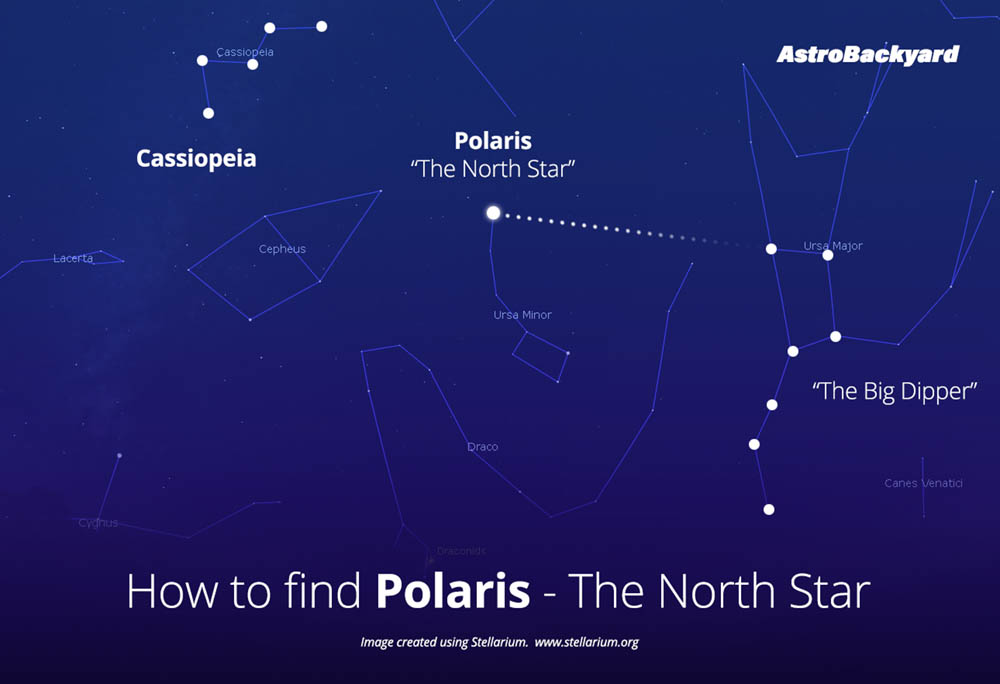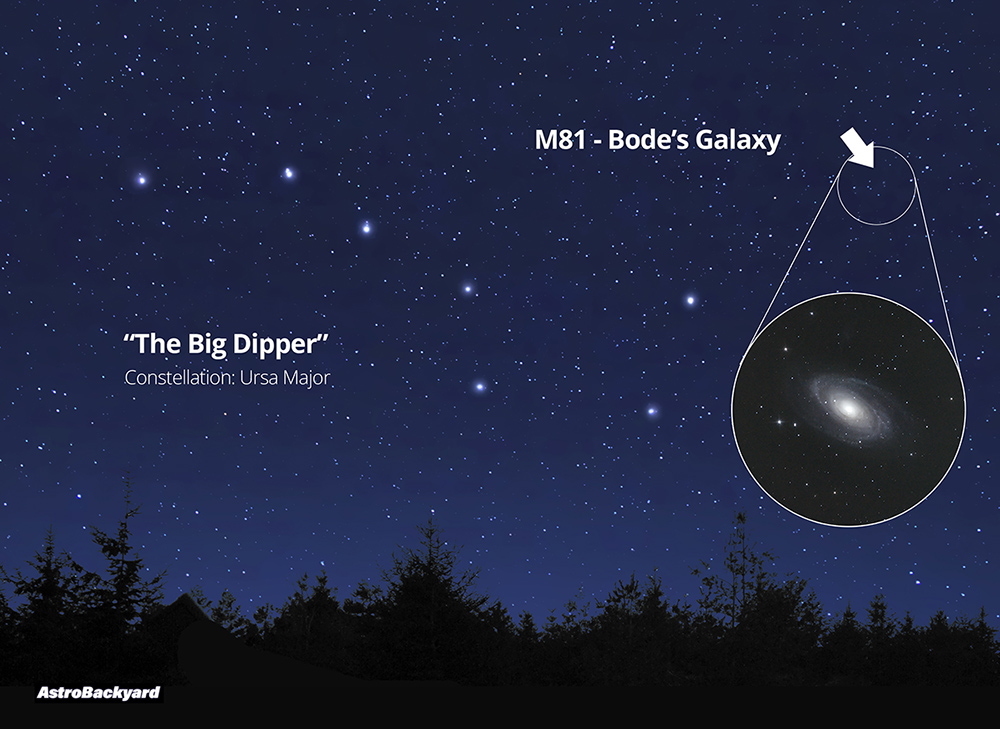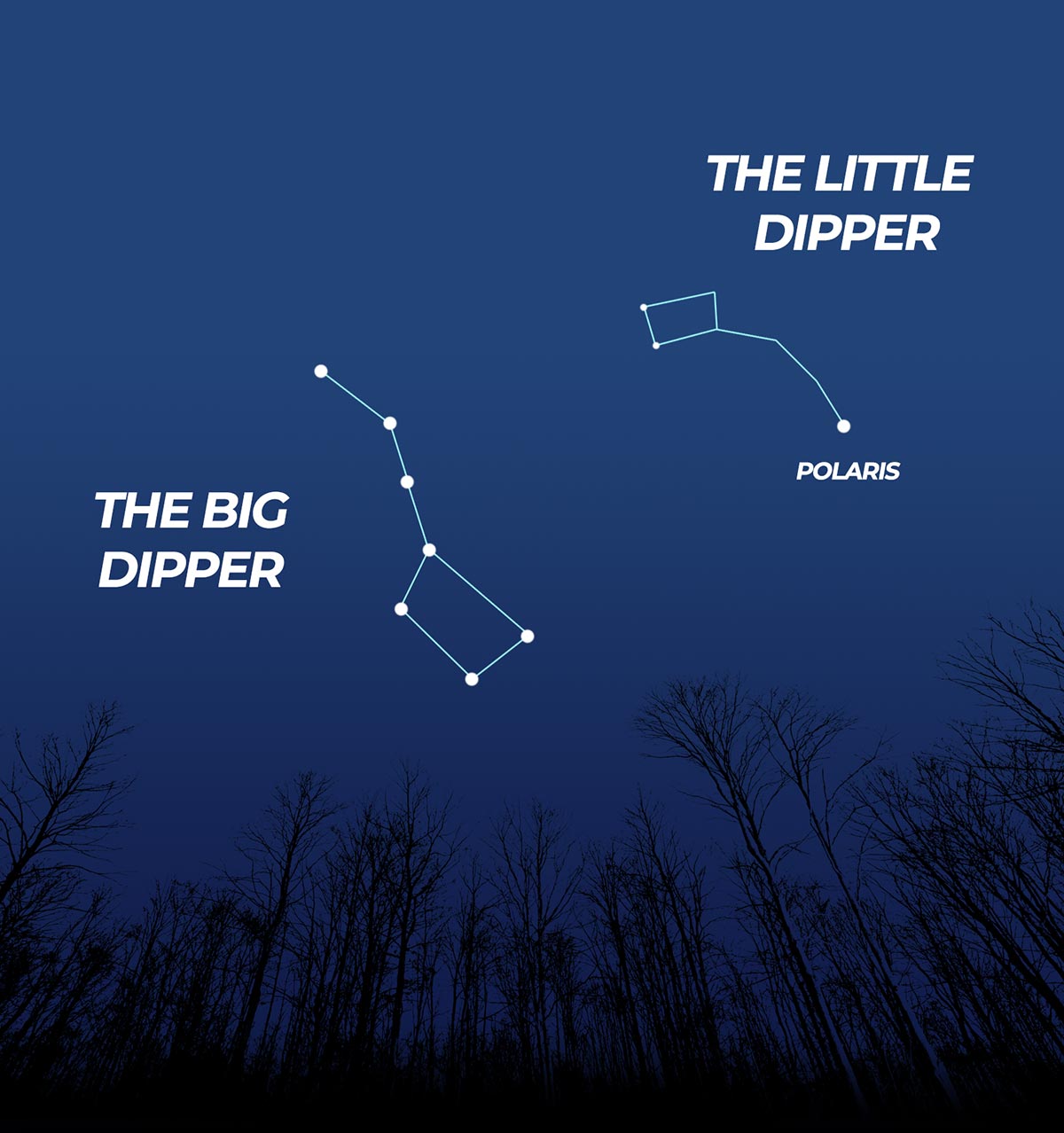The Big Dipper
The Big Dipper is one of the most recognizable and easily found patterns of stars in the night sky. It includes seven bright stars from the constellation Ursa Major with four stars forming the bowl and three stars forming the handle.
Ursa Major, also known as the Great Bear, is a large constellation that includes more stars than those in the Big Dipper.
However, the stars that make up the bear’s head, torso, legs, and feet are not as easy to see as the seven stars that make up the hindquarters/flank and tail which form the Big Dipper.
The Big Dipper is not a formal constellation but an asterism, a shape or pattern of stars that are often part of a constellation.
A photo of the Big Dipper asterism in the northern hemisphere sky. Trevor Jones.
Fast Facts
- Is the Big Dipper a Constellation? The Big Dipper is not a constellation, it is actually an asterism, a prominent grouping of stars that forms a star pattern. It is one of many famous asterisms in the night sky including ‘Orion’s Belt.’ and the ‘Summer Triangle’.
- What Constellation is the Big Dipper Part Of? The Big Dipper is part of a much larger constellation known as Ursa Major, the third largest of the modern 88 constellations.
- Where is the Little Dipper? The Little Dipper is in the constellation Ursa Minor, close to the North Star (Polaris). Use the two stars in the Big Dipper bowl to draw an imaginary line toward Polaris, which is the end of the Little Dipper handle.
- How did the Big Dipper get its Name? The Big Dipper gets its name from its resemblance to a pan or measuring cup with a bent handle. The Big Dipper has many different names including the Wagon and the Plow.
- How Many Stars are there in the Big Dipper? There are 7 stars in the Big Dipper. The stars are Dubhe, Merak, Phecda, Megrez, Alioth, Mizar, and Alkaid.
Stars in the Big Dipper
There are seven stars that make up the asterism, they include:
- Dubhe
- Merak
- Phecda
- Megrez
- Alioth
- Mizar
- Alkaid
The Bowl
Dubhe (Alpha Ursae Majoris) is the second brightest star in the asterism and forms the upper outer portion of the bowl. It is an orange giant star with a visual magnitude of 1.79 and is approximately 83 light-years in distance.
Merak (Beta Ursae Majoris) forms the bottom outer portion of the bowl, with a mass three times that of the Sun. It is a white subgiant star with an apparent magnitude of 2.37 and is 79 light-years distant.
Phecda (Gamma Ursae Majoris) forms the bottom inner portion of the bowl. It is a main sequence dwarf star with an apparent magnitude of 2.4 and lies 83.2 light-years distant.
Megrez (Delta Ursae Majoris) is the dimmest star in the asterism, and forms the upper inner portion of the bowl, connecting to the first star in the handle. It is a main-sequence star and lies 80.5 light-years in distance.
The Handle
Alioth (Epsilon Ursae Majoris) is the brightest of the seven stars in the asterism and is the start of the handle. It has a visual magnitude of 1.77 and is 82.6 light-years away.
Mizar (Zeta Ursae Majoris) is a multiple-star system with two binary stars and is located in the middle of the handle. It has an apparent magnitude of 2.23 and is 83 light-years away.
Alkaid (Eta Ursae Majoris) is a young blue main-sequence star and is the third brightest in the Ursa Major constellation. It forms the end of the handle with an apparent magnitude of 1.86 and is roughly 104 light-years distant.
How to Find the Big Dipper
Ursa Major, and therefore the Big Dipper, is visible at latitudes between +90 and -30 degrees on most clear nights in the northern hemisphere.
Both the Big Dipper and Little Dipper are circumpolar, meaning they rotate counterclockwise around the North Star as the Earth spins and never dip below the horizon at night.
There is an old saying ‘spring up and fall down’ that refers to the Big Dipper’s position in the sky during the seasons. In spring and summer, the asterism will be at its highest in the sky, while during the fall and winter, it will be closer to the horizon.
Look for a dot-to-dot pattern in the shape of a kitchen ladle. If you locate the Big Dipper then you can easily locate the Little Dipper and North Star.
Video explaining how to find the Big Dipper. (wikiHow on YouTube).
Big Dipper, the Guide
Since the Big Dipper is easy to find in the sky, it makes a good starting point for beginners to learn about the stars in the northern hemisphere. For this reason, it is also used as a guide to locate other stars in the sky and surrounding deep-sky objects.
For example, the best way to locate the Little Dipper (i.e. Ursa Minor) and the North Star (i.e. Polaris) is to use the Big Dipper.
The two outer stars of the bowl, Merak and Dubhe, point towards the end of the handle in the Little Dipper. An imaginary line between the two stars from the Big Dipper will extend towards Polaris.
Use the Big Dipper to find Polaris the ‘North Star’
If your sky is dark enough, once you have found Polaris you will also be able to find the rest of the Little Dipper. Its stars are rather dim so it is not as easy to observe from a light-polluted sky.
It can also be used to find noteworthy nearby deep-sky objects such as M81 (Bode’s Galaxy), M82 (Cigar Galaxy), M101 (Pinwheel Galaxy), and M51 (Whirlpool Galaxy).
Use the Big Dipper to find other deep-sky objects
Why is the Big Dipper sometimes upside down?
The Big Dipper appears upside down at certain times of the year because of Earth’s rotation. The Big Dipper lies close to Polaris (The North Star) in the northern hemisphere night sky.
This is the point where all of the other stars in the night sky appear to rotate around as the Earth spins on its axis. We see the Big Dipper at different angles (including upside down) as it circles the North Star in the sky.
Origins and Associations
There are many parallels associated with Ursa Major and the Big Dipper among different cultures.
Some Native Americans believe the bowl is actually the bear and the stars in the handle are warriors chasing the bear.
In the United Kingdom and Ireland, the Big Dipper is known as the Plough and is thought to have been associated with an old Nordic constellation that was believed to represent a wagon or chariot.
It is seen as a ladle (China/Japan), a cleaver (northern England), a cart/wagon (Germany/Hungry), and a coffin (Saudi Arabia).
It was also associated with the Underground Railroad during the Civil War. Slaves referenced the asterism in a song called ‘Follow the Drinking Gourd’ which provided directions to follow the Big Dipper to the north and freedom.
More Asterisms in the Night Sky
- What is So Special About Orion’s Belt?
- What is the significance of the ‘Summer Triangle’?
- How to Find the Winter Triangle in the Night Sky





